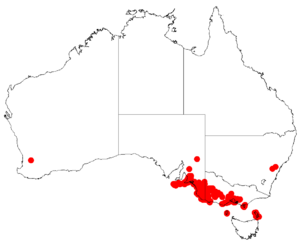Horny cone-bush facts for kids
Quick facts for kids Horny cone-bush |
|
|---|---|
 |
|
| Scientific classification | |
| Genus: |
Isopogon
|
| Species: |
ceratophyllus
|
 |
|
| Occurrence data from Australasian Virtual Herbarium | |
| Synonyms | |
|
Atylus ceratophyllus (R.Br.) Kuntze |
|
The Horny Cone-bush (scientific name: Isopogon ceratophyllus) is a unique plant found only along the coasts of Victoria and South Australia, and on some islands in Tasmania. It's also called the Wild Irishman. This plant is a small, woody shrub, meaning it has a tough, woody stem, and it can grow up to 100 centimeters (about 3 feet) tall. It has prickly leaves. The Horny Cone-bush is part of the Proteaceae plant family. It is very sensitive to a plant disease called dieback.
Contents
What Does It Look Like?
The Horny Cone-bush is a prickly shrub. It usually grows between 15 and 100 centimeters (about 6 to 40 inches) tall. It can spread out to about 120 centimeters (4 feet) wide.
Its flowers grow in oval or round shapes. These flower heads are called inflorescences. They are about 3 centimeters (just over an inch) across. You can see these flowers blooming between July and January.
Naming the Horny Cone-bush
The scientific name for this plant is Isopogon ceratophyllus. A botanist named Robert Brown first described it in 1810. He wrote about it in his book Prodromus Florae Novae Hollandiae et Insulae Van Diemen.
The name ceratophyllus comes from two Ancient Greek words. "Cerat-" means "horn," and "phyllon" means "leaf." This name was chosen because the plant's leaves look a bit like animal antlers.
Besides its scientific name, people also call it the Horny Cone-bush. On Kangaroo Island, it's known as the Wild Irishman.
Where Does It Live?
The Horny Cone-bush grows in a few specific places. You can find it in south-western Victoria and the south-eastern part of South Australia. It also lives on some islands in the Bass Strait, which are part of the Furneaux Group. These islands include Flinders, Cape Barren, and Clarke Islands.
This plant is the only Isopogon species found in South Australia. It likes to grow in sandy soils. You can often find it in open eucalyptus forests, woodlands, or areas with heathland plants.
Challenges for the Horny Cone-bush
The Horny Cone-bush faces a big threat from a disease called dieback. This disease is caused by a tiny organism called Phytophthora cinnamomi. The plant is extremely sensitive to this pathogen.
Studies have shown how serious this problem is. For example, in the Brisbane Ranges, many Horny Cone-bushes disappeared after dieback hit. Even after 30 years, they had not grown back. This happened even though other plants that were also sensitive to the disease started to grow again after about 10 years.
All the groups of Horny Cone-bushes in Tasmania are at risk of being wiped out by this disease. Plants are dying at Wingaroo Nature Reserve on Flinders Island because of exposure to P. cinnamomi.
Growing This Plant
The Horny Cone-bush is not often grown in gardens. It grows slowly and needs special conditions to thrive. It requires soil that drains water well but also stays moist. It would be a good plant for a rockery garden.

